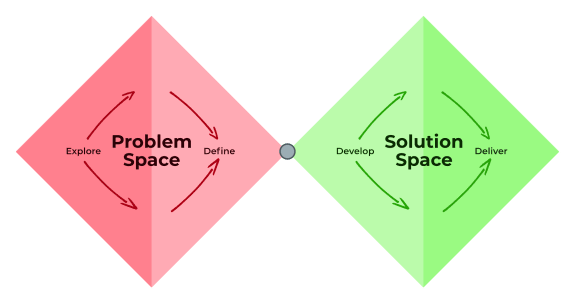If you want to speed up your team, should you run faster or slower as their leader? Today, I found one answer.
Today, I joined two working sessions back-to-back. The topics were totally unrelated, and the participants were different—yet the second session delivered an answer to a question that arose in the first.
The question was:
Didn’t we clarify this already? Do we really have to do this again?
Me, feeling stuck in a loop
Déjà Vu? ¶
Our team has recently started working on a new project. During today’s session, the team felt the need to redefine the “Big Urgent Problem” (also known as BUP) that we want to address with this project—its “Reason Why.”
So, we invested some time to come up with a description of the BUP. And the overall result, in my opinion, matched the description of the BUP we already had before.
I scratched my head. Why had the team felt this need to return and redefine what we already had defined earlier—with arguably the same result?
Switching Perspectives Helps ¶
In the following session, I met a leader of a different team to help design his upcoming kick-off in my role as facilitator. So, I switched perspectives from team member to facilitator.
Whenever a team starts working on a new challenge, I use the following double diamond as a framework for kick-offs:

This model stems from Design Thinking and basically states: Before you can solve any problem, you need to understand it well. This understanding culminates in the problem definition that represents the starting point for the development of solutions.
What seems obvious and common sense, gets forgotten frequently. People tend to jump to solutions way too early. Hence the saying:
Love the problem, not the solution.
As I went on to design how his team could learn about the problem, the team leader asked me: “Why do we need this? The problem is already clear!”
Then it hit me.
The problem was already clear to him. From his perspective there was no need to clarify further. He missed however, that he had thought the problem through many times and from many different angles—while it was entirely new to his team. He knew the problem and now just wanted to focus on solutions.
And the same applied to the session before: While I felt the problem was already well defined for me, it wasn’t the case for the rest of the team. Sure enough: Back then, it was me who synthesized the problem definition from everyone’s input. That’s why I had put in more thought than the others, that’s why I had a head start.
The Lesson: Who Leads Goes Ahead—and Returns ¶
On the meta level, I now understood a bit better what leadership means:
Leaders venture ahead and think about stuff that others don’t think about just yet. Just like a scout. Then, leaders return and retrace their thoughts together with their team. Leadership isn’t about sparing your team to think things through—it’s about having it thought through before bringing the rest of the team on the ride with you.
This approach ensures two aspects:
- As a leader, you only deploy your team when you have at least a vague sense that the endeavour is worth the investment.
- As a leader, you can learn from your team and compensate blind spots and biases.

In other words: Leaders must repeat themselves and their thought process. If they don’t, their teams don’t explore and define the problem well enough for them and might get stuck.
So, to accelerate their team, leaders must run fast on their own—then return and run slow together with their team. A bit like Disney’s character Turbo, a slow snail that can run very fast, too.
Conclusion ¶
This article illustrates how people can disconnect when running with different speeds. While leaders are required to run fast—i.e., think ahead—they’re also required to return and decelerate to their team’s speed.
Why? Because teams appear to slow down if their leaders run too fast ahead—without returning and retracing their steps at the team’s pace.
Which adds further truth to the saying:
If you want to go fast, go alone; if you want to go far, go together.

Michael Schmidle
Founder of PrioMind. Start-up consultant, hobby music producer and blogger. Opinionated about technology, strategy, and leadership. In love with Mexico. This blog reflects my personal views.
Oct 6, 2024 · 4min read
Revolutionizing Decision-Making
Last year, I shared a simple framework for making better decisions. Little did I know it would spark a journey that led to creating PrioMind, an app that’s revolutionizing how we approach choices. Here’s the story of how four criteria evolved into a powerful decision-making tool, and what I’ve learned along the way. Continue…
Mar 5, 2023 · Oct 6, 2024 · 13min read
Four Criteria for Better Decision Making
While we all face decisions on a daily basis, we often reinvent the wheel in our process of decision making. However, there’s a set of strategic criteria that helps you making robust, fast, and comprehensible choices every time. Continue…
Jun 4, 2022 · 6min read
The Power of Subtractive Thinking
What’s better: more success or less failure? More possibilities or less impossibilities? Let’s take a look at the seemingly pointless question—and discover the surprising answer. Continue…
Feb 6, 2022 · 6min read
A Visualization of Leadership
Recently, I came across a helpful visualization of what Leadership means in times of Digital Transformation. Let me show you. Continue…



